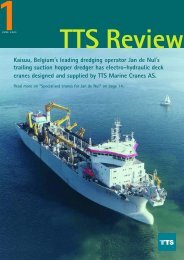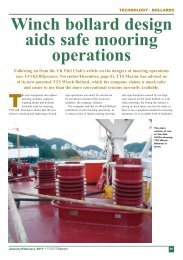You also want an ePaper? Increase the reach of your titles
YUMPU automatically turns print PDFs into web optimized ePapers that Google loves.
Linkspans<br />
The Stena Line relocation project<br />
Specialists from <strong>TTS</strong> Port Equipment are close to completing one of the most extraordinary<br />
relocation projects in the history of the marine industry<br />
Technical manager Mikael<br />
Jimmerfors takes us through the<br />
story. “Eleven or twelve years ago,<br />
while working for a different company,<br />
we designed six linkspans for Stena Line’s<br />
HSS fast ferry services. These linkspans<br />
form an integrated part of the vessel, and<br />
are designed to minimise turnaround<br />
times and reduce fuel consumption. The<br />
linkspan concept has been a great<br />
success – Stena is able to load or unload<br />
1,500 passengers, as well as cars and<br />
buses, in 15 minutes.”<br />
The linkspans, which are semisubmersible,<br />
measure 40m long by 40m<br />
wide and weigh over 1,000 tonnes, were<br />
installed at the terminals for Stena’s<br />
Holyhead–Dun Laoghaire, Belfast–<br />
Stranraer and Harwich–Hoek van Holland<br />
routes. However, Stena recently decided<br />
to close down the latter service and came<br />
to Jimmerfors and his colleague, project<br />
manager Klaes Lundberg, now working<br />
for <strong>TTS</strong>, for help with the linkspan.<br />
“The linkspans installed in Harwich<br />
and Hoek van Holland were newer, and of<br />
an upgraded design,” says Lundberg. “So<br />
Stena simply asked us if we could move<br />
them to Scotland and Northern Ireland<br />
for use on the Belfast–Stranraer route.”<br />
This was a challenge. When the<br />
linkspans were originally installed, giant<br />
floating cranes were used to lift them<br />
into place. These particular cranes,<br />
though, are now deployed elsewhere<br />
around the world. “To lift them with<br />
cranes wasn’t practical, because the best<br />
window the crane company could give us<br />
was ‘The first or second half of the year.’<br />
But we only had a one or two week<br />
window to do the work!” says<br />
Jimmerfors.<br />
4 <strong>TTS</strong> <strong>Review</strong> • April 2008<br />
So the <strong>TTS</strong> engineers decided that the<br />
best alternative was a skidding and jackup<br />
operation. Using a giant North Sea<br />
barge as the main jack-up platform and<br />
transport vehicle, they had to get the<br />
outer end of the linkspan on to the barge,<br />
then remove the pontoon from the<br />
linkspan – essentially by cutting off its<br />
legs. This made the pontoon extremely<br />
unstable, another challenge given the<br />
three-metre high tide, six knot tidal race<br />
and the wake from ocean-going vessels<br />
coming in and out of the port of<br />
Rotterdam every five minutes. “The work<br />
was precision – landing the linkspan on<br />
the barge and releasing it from the bank<br />
had to be accurate within millimetres,”<br />
says Lundberg. “When it came to<br />
Positioning the barge to support the linkspan<br />
before removal of the underwater pontoon<br />
“<br />
The trickiest part<br />
was the handling<br />
of the submerged<br />
pontoon – it<br />
weighs 150 tonnes<br />
and we had to<br />
bring it through<br />
the surface of the<br />
water, which<br />
completely<br />
changed its<br />
stability<br />
”


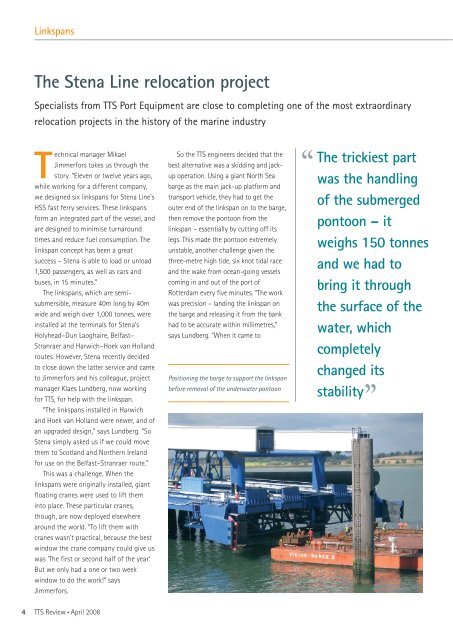


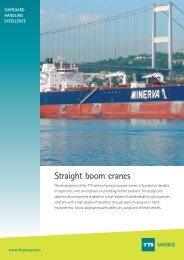

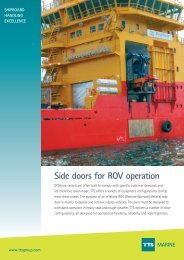
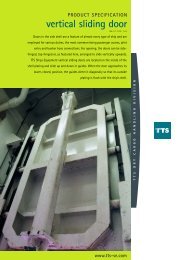
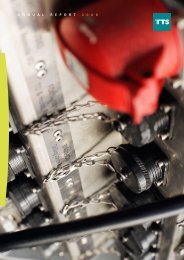

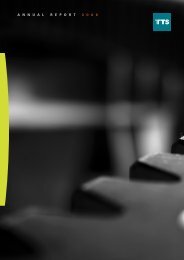
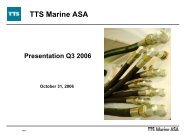
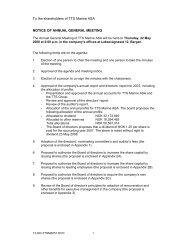
![2012.MasterPresentation_final [Compatibility Mode] - TTS Group ASA](https://img.yumpu.com/4612021/1/190x146/2012masterpresentation-final-compatibility-mode-tts-group-asa.jpg?quality=85)
